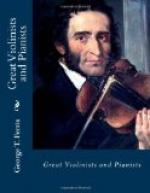perfect, polished, and elaborately wrought. The
distinguished American litterateur, Mr. George William
Curtis, who heard him in New York in 1857, thus wrote
of him: “He is a proper artist in this,
that he comprehends the character of his instrument.
He neither treats it as a violoncello nor a full orchestra.
Those who in private have enjoyed the pleasure of
hearing—or, to use a more accurate epithet,
of seeing—Strepitoso, that friend of mankind,
play the piano, will understand what we mean when
we speak of treating the piano as if it were an orchestra.
Strepitoso storms and slams along the keyboard until
the tortured instrument gives up its musical soul in
despair and breaks its heart of melody by cracking
all its strings.... Every instrument has its
limitations, but Strepitoso will tolerate no such
theory. He extracts music from his piano, not
as if he were sifting the sands for gold, but as if
he were raking oysters.... Now, Thalberg’s
manner is different from Strepitoso’s. He
plays the piano; that is the phrase which describes
his performance. He plays it quietly and suavely.
You could sit upon the lawn on a June night and hear
with delight the sounds that trickled through the
moonlight from the piano of this master. They
would not melt your soul in you; they would not touch
those longings that, like rays of starry light, respond
to the rays of the stars; they would not storm your
heart with the yearning passion of their strains,
but you would confess it was a good world as you listened,
and be glad you lived in it—you would be
glad of your home and all that made it homelike; the
moonlight as you listened would melt and change, and
your smiling eyes would seem to glitter in cheerful
sunlight as Thalberg ended.”
Thalberg’s style was, perhaps, the best possible
illustration of the legitimate effects of the pianoforte
carried to the highest by as perfect a technique as
could possibly be attained by human skill.
That he lacked poetic fire and passion, that the sense
of artistic restraint and a refined fastidiousness
chilled and fettered him, is doubtlessly true.
Whether the absence of the imaginative warmth and
vigor which suffuse a work of art with the glow of
something that can not be fully expressed, and kindle
the thoughts of the hearer to take hitherto unknown
flights, is fully compensated for by that repose and
symmetry of style which know exactly what it wishes
to express, and, being perfect master of the means
of expression, puts forth an exact measure of effort
and then stops as if shut down by an iron wall—this
is an open question, and must be answered according
to one’s art theories. The exquisite modeling
of a Benvenuto Cellini vase, wrought with patient
elaboration into a thing of unsurpassable beauty, does
not invoke as high a sense of pleasure as an heroic
statue or noble painting by some great master, but
of its kind the pleasure is just as complete.
Apart from Thalberg’s power as a player, however,




